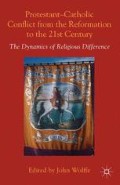Abstract
The inseparability of Christianity from the exercise of power by secular authorities in the Reformation era does not diminish the continuing ideological utility of singling out –religion’ as a supposedly discrete domain of human life particularly prone to violence.1
Access this chapter
Tax calculation will be finalised at checkout
Purchases are for personal use only
Preview
Unable to display preview. Download preview PDF.
Notes
Brad S. Gregory, The Unintended Reformation. How a Religious Revolution Secularized Society (Cambridge, MA: Belknap Press for Harvard University Press, 2012), pp. 162–3.
Michel Figeac, ed., Les affrontements religieux en Europe (Paris: Editions SEDES, 2008)
Benoist Pierre, Affrontements religieux: Europe (XVI-XVIIe siècle) (Paris: Atlande, 2009)
Lucien Bély, ed., Les affrontements religieux en Europe (1500–1650) (Paris: PUPS, 2009)
Wolfgang Kaiser, ed., L’Europe en conflits: Les affrontements religieux et la genèse de l’Europe moderne (vers 1500–1650) (Rennes: Presses Universitaires de Rennes, 2009).
J.-S. Bailly, Mémoires d’un témoin de la Révolution 2 vols (Geneva: Droz, 1975), ii.284.
J.N. Wood, ‘Protestant-Catholic Relations and the Roots olthe First Popular Counter-revolutionary movement in France’, Journal of Modern History 43 (1971), 245–75.
Janet Gray, ‘The Origin ol the word Huguenot’, Sixteenth Century Journal, 14 (1983), 349–59
Philippe Joutard, ed., Historiographie de la réforme (Paris: Delachaux Niestle, 1977)
Philippe Joutard, Janine Estèbe, Elisabeth Labrousse, and Jean Lecuir, La Saint-Barthélémy ou les résonances d’un massacre (Neuchâtel: Editions Zeithos, 1976)
H. Dubiel, and J. Poujouls, eds, La France protestante: Histoire et lieux de mémoire (Montpellier: Presses du Languedoc, 1992)
Jacques Berchtold and Marie-Madeleine Fragonard eds, La mémoire des Guerres de religion: la concurrence des genres historiques (XVIe-XVIIIe siècles) (Geneva: Droz, 2007).
Carolyn Lougee Chappell, ‘Emigration and Memory: Alter 1685; Alter 1789’, in Rudoll Dekker, ed., Egodocuments and History: Autobiographical Writing in its Social Context in the Middle Ages, (Hilversum: Faculteit der Historische en Kunstwetenschappen Maatschappijgeschiedenis, 2002), pp. 89–106
Carolyn Lougee Chappell, ‘Family Bonds across the Reluge’, in Bertrand Van Ruymbeke and Randy J. Sparks, eds, Memory and Identity: the Huguenots and their Diaspora (Columbia, SC: University ol South Carolina Press, 2002), pp. 180–93.
Hubert Bost, ed., Ces Messieurs de la RPR: Histoires et écritures de huguenots, xvii-xviiie siècles (Paris: Champion, 2001).
Pierre Matthieu, Histoire des derniers troubles de France. Sous les règnes des rois très chrestiens Henri III...& Henri IUI (Lyon: E. Bonaventure, 1596).
William T. Cavanaugh, Fhe Myth of Religious Violence (New York: Oxford University Press, 2009)
Konrad Repgen, ‘What is a Religious War?’, in E.J. Kouri and Tom Scott, eds, Politics and Society in Reformation Europe (New York: Macmillan, 1987), pp. 311–28.
Luc Racaut, Hatred in Print: Catholic Propaganda and Protestant Identity during the French Wars of Religion (Aldershot: Ashgate, 2002)
Luc Racaut, ‘Accusations of infanticide on the eve of the French wars of religion’, in M. Jackson, ed., Infanticide: Historical perspectives on child murder and concealment, 1550–2000 (Aldershot: Ashgate, 2002), pp. 18–34.
C. Scott Dixon, Dagmar Freist, and Mark Greengrass, eds, Living with Religious Diversity in Early Modern Europe (Aldershot: Ashgate, 2009).
Keith P. Luria, Sacred Boundaries: Religious Coexistence and Conflict in Early-Modern Trance (Washington: Catholic University of America Press, 2005)
Alexandra Walsham, Charitable Hatred. Tolerance and Intolerance in England, 1500–1700 (Manchester: Manchester University Press, 2005).
Heinz Schilling, ed., Die reformierte Konfessionalisierung in Deutschland: Das Problem der “Zweiten Reformation” (Gütersloh: Gerd Mohn Verlag, 1986)
David El-Kenz, Les Bôchers du roi; la culture protestante des martyrs (1525–1572) (Seyssel: Champ Vallon, 1997)
David El-Kenz, ‘Le “service du Roy” contre le “service de Dieu”?’, Bulletin de la société de l’histoire du protestantisme français, 144 (1998), 415–28.
Denis Crouzet, La nuit de la Saint-Barthélémy: un rêve perdu de la renaissance (Seyssel: Champ Vallon, 1994).
Ariette Jouanna, La Saint-Barthélémy: Les mystères d’un crime d’Etat, 24 aoôt 1572 (Paris: Gallimard, 2007).
Paul Ricoeur, ‘Evénement et sens’ in Raisons pratiques: L’événement en perspective 2 (1992), 41–56.
Jacques Sémelin, Purifier et détruire: Usages politiques des massacres et génocides (Paris: Seuil, 2005)
David El-Kenz, ed., Le Massacre, objet d’histoire (Paris: Gallimard, 2005).
Ibid., pp. 139–174; cl Olivier Christin, ‘Iconographie de l’iconoclasme: à propos de la mutilation du portail de la cathédrale de Bourges (1562)’ in Actes de la recherche en sciences sociales 75 (1988), 50–3.
Denis Crouzet, Dieu en ses royaumes: Une histoire des guerres de religion (Seyssel: Champ Vallon, 2008).
A. Sanfaçon, ‘Evénement, mémoire et mythe: le siège de Chartres de 1568’, in Claire Dolan, ed., Evénement, identité et histoire (Sillery: Septentrion, 1990), pp. 187–204.
Recounted in D. Roche, ed., Journal de ma vie, Jacques Louis Ménétra, compagnon vitrier au XVIIIe siècle (Paris: Montalba, 1982), pp. 120–1.
Author information
Authors and Affiliations
Editor information
Editors and Affiliations
Copyright information
© 2013 Mark Greengrass
About this chapter
Cite this chapter
Greengrass, M. (2013). Europe’s ‘Wars of Religion’ and their Legacies. In: Wolffe, J. (eds) Protestant-Catholic Conflict from the Reformation to the Twenty-first Century. Palgrave Macmillan, London. https://doi.org/10.1057/9781137289735_2
Download citation
DOI: https://doi.org/10.1057/9781137289735_2
Publisher Name: Palgrave Macmillan, London
Print ISBN: 978-1-349-45023-7
Online ISBN: 978-1-137-28973-5
eBook Packages: Palgrave History CollectionHistory (R0)

